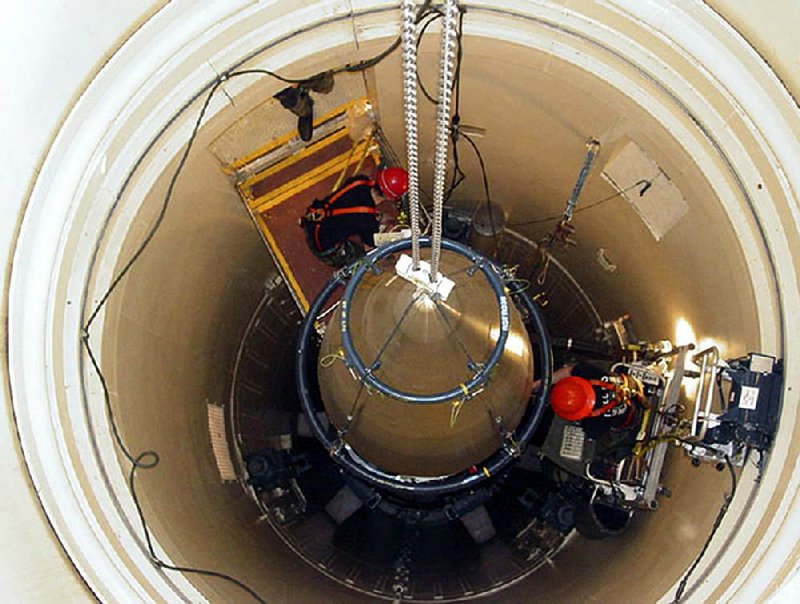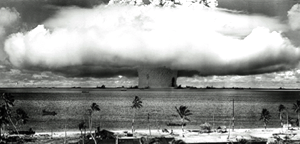WASHINGTON -- An Air Force security team's botched response to a simulated assault on a nuclear missile silo has prompted a blistering review followed by expanded training to deal with the scenario of a real attack.
The Air Force recognized the possibility of such an intrusion as more worrisome after the Sept. 11, 2001, terrorist attacks. But an internal review of the exercise held last summer at Malmstrom Air Force Base in Montana said the security forces were unable to speedily regain control of the captured silo, which it called a "critical deficiency."
The Associated Press obtained a copy of the report through a Freedom of Information Act request.
The previously unreported misstep was the reason the 341st Missile Wing flunked a broader safety and security inspection. The unit, which has been beset by other problems in recent months, including an exam-cheating scandal that led its commander to resign in March, passed a do-over of the security portion of the inspection last October.
The failure was one of a string of nuclear missile corps setbacks revealed by the AP over the past year. The force has suffered security, leadership and training lapses; discipline breakdowns; and morale problems. Earlier this year, Defense Secretary Chuck Hagel ordered two reviews, still underway, to address his concern that the lapses could erode public trust in the security of the nation's nuclear weapons.
The partially censored document obtained by the AP indicates that the security team was required to respond to the simulated capture of a Minuteman 3 nuclear missile silo by hostile forces -- called an "Empty Quiver" scenario in which a nuclear weapon is lost, stolen or seized. Each of the Air Force's 450 Minuteman 3 silos contains an intercontinental ballistic missile armed with at least one nuclear warhead and ready for launch on short notice on orders from the president.
The Air Force review examined why the security force showed an "inability to effectively respond to a recapture scenario." It cited a failure to take "all lawful actions necessary to immediately regain control of nuclear weapons" but did not specify those actions.
A section apparently elaborating on what was meant by the phrase "failed to take all lawful actions" was removed from the document before its release to the AP last week. The Air Force said this was withheld in accordance with Pentagon orders "prohibiting the unauthorized dissemination of unclassified information pertaining to security measures" for the protection of "special nuclear material."
The document provided no details on how the silo takeover was simulated, the number of security forces ordered to respond or other basic aspects of the exercise.
In 2009, the Air Force cited a "post-9/11 shift in thinking" about such situations, saying that while the scenario once was considered an impossibility, the U.S. "no longer has the luxury of assuming what is and what is not possible."
The Defense Threat Reduction Agency, which helped conduct the Malmstrom inspection last August, has called its inspections "likely the most intense, invasive and critical" in the U.S. military. The agency states on its website that its drills are designed to "ensure everybody knows their job, the proper procedures -- and how to react when chaos unfolds and the situation changes."
When the Air Force publicly acknowledged the broader inspection failure in August, it said "tactical-level errors" had been committed during one phase of the inspection, but it did not say the errors were made by security forces. At the time, the Air Force declined to provide details, saying to do so could expose potential vulnerabilities.
The report provided to the AP states that because security of nuclear weapons is paramount, "the inability to demonstrate effective recapture/recovery TTPs [tactics, techniques and procedures] detracts from the Wing's ability to conduct its day-to-day mission."
The document describes in broad terms the nature of the inspection failure, its significance and its underlying causes.
It said insufficient training was at the heart of the problem, beginning with a lack of familiarity among the security forces with "complex scenario" exercises. It also cited unspecified shortcomings in "leadership culture" and a lack of standardized simulations not only at Malmstrom but throughout the nuclear missile corps.
Among the corrective measures cited in the report: arrange to hold recapture exercises at one launch silo among the 50 silos in each of the 341st's three Minuteman squadrons, using "realistic, varied, simple-to-complex" scenarios based on what the Pentagon calls its "local nuclear security threat capabilities assessment." Also, the Air Force is taking steps to more closely track lessons learned from each "recapture" exercise.
The Air Force document did not identify or otherwise describe the security team, but each Minuteman 3 missile base has "tactical response force" teams specially trained and equipped for nuclear weapons recovery.
Lt. Col. John Sheets, a spokesman for the Air Force Global Strike Command, which is responsible for the nuclear missile corps as well as the nuclear-capable bomber aircraft, said Wednesday that he could not comment further.
He added that all "countermeasures," or corrective actions, that were proposed in the review obtained by the AP have been accomplished. The only exception is a plan for more extensive practicing of security response tactics at launch silos, an effort that requires signed agreements with owners of the private land on which the missile silos are situated.
The silos are concrete-lined holes in the ground, mostly on remote stretches of private land whose owners have accommodated the facilities since they were built in the 1960s.
A Section on 05/23/2014


